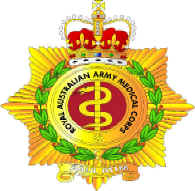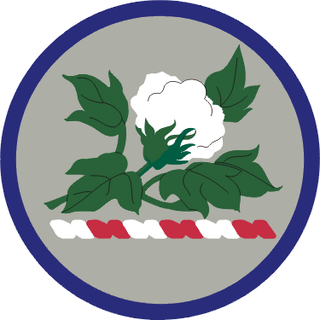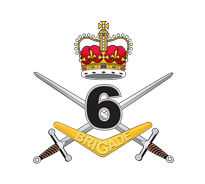
The Slovenian Armed Forces or Slovenian Army are the armed forces of Slovenia. Since 2003, it is organized as a fully professional standing army. The Commander-in-Chief of the SAF is the President of the Republic of Slovenia, while operational command is in the domain of the Chief of the General Staff of the Slovenian Armed Forces.

The Australian Defence Force (ADF) is the military organisation responsible for the defence of Australia. It consists of the Royal Australian Navy (RAN), Australian Army, Royal Australian Air Force (RAAF) and a number of 'tri-service' units. The ADF has a strength of just under 80,000 full-time personnel and active reservists, and is supported by the Department of Defence and several other civilian agencies.

A brigade is a major tactical military formation that is typically composed of three to six battalions plus supporting elements. It is roughly equivalent to an enlarged or reinforced regiment. Two or more brigades may constitute a division.

The structure of the British Army is broadly similar to that of the Royal Navy and Royal Air Force, in that the four-star (general-equivalent) field commands have been eliminated. Army Headquarters is located in Andover, Hampshire. As the top-level budget holder, this organisation is responsible for providing forces at operational readiness for employment by the Permanent Joint Headquarters. There is a Commander Field Army and a personnel and UK operations command, Home Command.

The Swedish Army is a branch of the Swedish Armed Forces whose main responsibility is land operations.

The Royal Danish Army is the land-based branch of the Danish Defence, together with the Danish Home Guard. For the last decade, the Royal Danish Army has undergone a massive transformation of structures, equipment and training methods, abandoning its traditional role of anti-invasion defence, and instead focusing on out of area operations by, among other initiatives, reducing the size of the conscripted and reserve components and increasing the active component, changing from 60% support structure and 40% operational capability, to 60% combat operational capability and 40% support structure. When fully implemented, the Danish Army will be capable of deploying 1,500 troops permanently on three different continents continuously, or 5,000 troops for a shorter period of time, in international operations without any need for extraordinary measures such as parliamentary approval of a war funding bill.

The Royal Australian Army Medical Corps (RAAMC) is the branch of the Australian Army responsible for providing medical care to Army personnel. The AAMC was formed in 1902 through the amalgamation of medical units of the various Australian colonies and was first deployed to South Africa as a small detachment of personnel supporting the Australian Commonwealth Horse during the Second Boer War. The corps has participated in every Australian Army operation since then, including wars and peacekeeping operations. The "Royal" prefix was granted in 1948.

This article describes the current structure of the Australian Army. It includes the army's order of battle and the headquarters locations of major units. Members of the Australian Army also serve within joint units of the Australian Defence Force which fall outside the direct command the Australian Army.

The 3rd Brigade is a combined arms brigade of the Australian Army, principally made up of the 1st and 3rd Battalions of the Royal Australian Regiment. Initially raised in 1903 as part of the post-Federation Australian Army, it was removed from the order of battle in 1906 following the restructure of the field force. It was re-formed in 1914 for service during World War I, taking part in the fighting at Gallipoli and on the Western Front in Europe. During World War II the brigade was used in a defensive role before it was disbanded in 1944. It was re-raised in 1967 for service during the Vietnam War and later went on to provide the nucleus of the deployment to East Timor during the Australian-led intervention in 1999. The brigade is currently based at Lavarack Barracks in Townsville, Queensland.

United States Army Forces Command (FORSCOM) is the largest United States Army command and provider of expeditionary, regionally engaged, campaign-capable land forces to combatant commanders. Headquartered at Fort Bragg, North Carolina, FORSCOM consists of more than 750,000 active Army, U.S. Army Reserve, and Army National Guard soldiers. FORSCOM provides enhanced land power gaining operational depth and versatility through a mix of fully integrated Active and Reserve Component forces operating in a joint, interagency, intergovernmental, and multinational (JIIM) environment. Its organizations are expeditionary, campaign focused, and tailorable to provide combatant commanders the required capabilities to be decisive across the range of military operations. FORSCOM was created on July 1, 1973, from the former Continental Army Command (CONARC).

Below is an estimated list of the major units deployed within the Multi-National Force - Iraq and other United States military units that were operating in Iraq under the U.S. Central Command (USCENTCOM) in 2009, during the Iraq War.

The Alabama Army National Guard is a component of the United States Army and the United States National Guard. National coordination of various state National Guard units are maintained through the National Guard Bureau.
This is the Operation Herrick ground order of battle, which lists any British ground forces that have taken part in the duration of Operation Herrick between 2002 and 2014.

The 82nd Airborne Division Sustainment Brigade is a sustainment brigade of the United States Army based at Fort Bragg, North Carolina. It provides logistical support to and is part of 82nd Airborne Division.
The 793rd Military Police Battalion was a Battalion sized unit in the United States Army stationed at Fort Richardson, Alaska. The battalion was responsible for all Regular Army Military Police units and operations in the state of Alaska. Traditionally since 1946, the battalion was located in Germany with subordinate companies scattered through the country, thus ending a rich Military Police history in postwar Germany in 2010 with relocation to Alaska. With the drawdown of troops in the US Army, the Army once again inactivated the Battalion 28 August 2014.
The 7th Combat Service Support Battalion is an Australian Army administration and logistics battalion which provides transport, supply and maintenance support services to units of the 7th Brigade. The battalion is made up of both Regular personnel and has recently been involved in deployments to Timor Leste, Iraq and Afghanistan.
The 1st Brigade is currently the largest unit of the New Zealand Army, and contains most of the army's deployable units. The brigade was formed on 13 December 2011 by amalgamating the 2nd Land Force Group and 3rd Land Force Group. Its establishment formed part of the 'Army 2015' package of reforms.

















